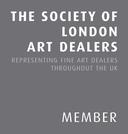L'enfant en Bleu

Edgar Degas is, of course, famous as one of the founders of the Impressionist movement. He was heavily influenced by the realism of artists such as Courbet and Corot and was instrumental in the avant garde Impressionist exhibitions. He is renowned for his later pastel and oil pictures of dancers, racehorse and interior scenes, in which he displays his superb draughtsmanship and the vivid colouristic techniques of the Impressionists.
Following his rigorous academic training, in 1856, Degas travelled to Italy where he stayed for three years, copying works by Michelangelo, Raphael, Titian and other Renaissance artists. Even then, however, Degas’ practice was different to other artists. Instead of concentrating on the main figure of the piece, Degas would hone in on a secondary figure which he would treat as a portrait. In this small study, we see the meticulous naturalism of Degas’ youth which subsequently gave way to an increasing abstraction of form. The influence of the dark Dutch palette is evident in the blending on the face and background of the child, however, in this small study we can discern Degas’ interest in colour, in the glorious teal of the child’s clothing and the soft red of the full mouth. Throughout his work, Degas created portrayals of human isolation and this portrait is psychologically compelling, haunting and ambiguous. It is a powerful and penetrating depiction of the subject, hinting at a narrative, and we are left uneasy, wondering about this child lurking in the shadows with his dark haunting eyes who does not meet our gaze but who appears still watchful.
It is believed that this painting is part of a larger canvas and that the figure is René Degas, Edgar’s younger brother by eleven years. René was one of his favourite early models and “used to tell us how no sooner had he put his books down when he got in from school than Edgar would grab him and make him pose." (Paul-André Lemoisne, 1931). René refused a position in his father’s banking business in Paris and instead went to work for his maternal uncle Michael Musson’s cotton business in New Orleans. He established De Gas Brothers, a wine and cotton import and export business, with his brother Achille. He married his first cousin Estelle (one of Edgar’s favourite models from the Musson family) about whom Edgar wrote: “He [René] is married and his wife, our cousin, is blind, poor thing, almost without hope. She has borne him two children, she is going to give him a third whose godfather I shall be, and as the widow of a young American killed in the War of Secession she already had a little girl of her own who is nine years old.” The couple went on to have five children, only two of whom survived. René’s misfortune continued and, having amassed enormous business debts, he had to borrow money from his father which contributed to the loss of the family’s fortune and bank in Paris. René eloped with America Durrive Olivier, godmother to his son Gaston, family friend and neighbour, after the death of his last son. After obtaining false divorce papers, the couple married bigamously, in Cleveland, Ohio. They then married legally in New York after René had divorced Estelle. In 1879, the couple returned to France with America’s first two children from her previous marriage and they went on to have three children of their own. In 1883, Réne’s children by Estelle were adopted by their maternal grandfather Michael Musson and they never saw their father again.
After his father’s death in 1874, Edgar had to pay off debts following his brother’s ruin and could no longer rely on his family’s wealth to support him. To make ends meet, he sold his house and inherited art collection, and for the first time in his life became dependent on the sale of his artwork. Under mounting financial pressure, Edgar embarked upon a decade of great productivity, joining forces with the budding impressionist movement to mount a series of paradigm-shifting exhibitions.
As he grew older, Edgar became increasingly reclusive and given to bouts of depression. Famously misanthropic, cantankerous and misogynistic, he believed that “the artist must live alone, and his private life must remain unknown.” Morose and withdrawn in part due to his deteriorating eyesight, he grew ever more isolated, with Renoir observing: “All his friends had to leave him; I was one of the last to go, but even I couldn’t stay til the end.” He remained a bachelor throughout his life and was not known to have any romantic entanglements; Manet noted that Degas was “not capable of loving a woman.” He died alone in 1917.
René reconciled with his brother before Edgar’s death and he inherited half of his estate which included several brothel scenes and nude paintings which he then destroyed. Picasso was an eager and fascinated collector of such pieces, owning twelve of them. He described them as “far and away the best thing he ever did” and inspired by them, created his own series of voyeuristic prints in his later years. René’s children in Paris had no knowledge of their half siblings in New Orleans until their father’s death in 1921 when his estate was divided between his two families.



